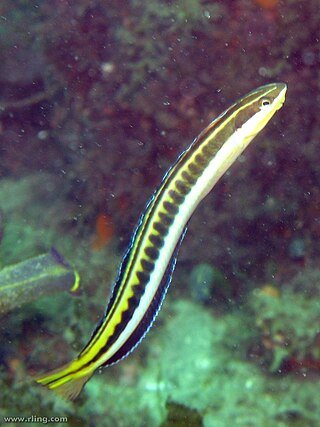
The mimic blenny or piano fangblenny, Plagiotremus tapeinosoma, is a blenny of the genus Plagiotremus, with a widespread Indo-Pacific distribution including New Zealand from depths of 8 to 30 metres. This species reaches a length of 14 centimetres (5.5 in) TL.
Enchelyurus flavipes, the yellowfin blenny, is a species of combtooth blenny from the western Pacific Ocean. It occasionally makes its way into the aquarium trade.
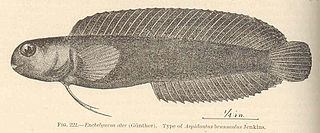
Enchelyurus is a genus of combtooth blennies found in the Pacific and Indian Oceans.

Enchelyurus brunneolus is a species of combtooth blenny found in coral reefs in the eastern central Pacific ocean, around Hawaii. This species grows to a length of 2.9 centimetres (1.1 in) SL.
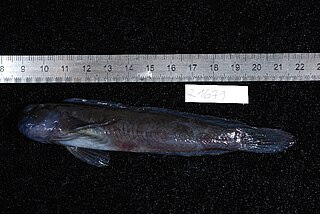
Enchelyurus kraussii, Krauss' blenny, is a species of combtooth blenny found in coral reefs in the western Pacific and Indian Oceans. This species grows to a length of 4.5 centimetres (1.8 in) SL. The specific name honours the German scientist, traveller and collector Christian Ferdinand Friedrich Krauss (1812–1890).
Enchelyurus petersi is a species of combtooth blenny found in the western Indian Ocean, in the Red Sea. This species grows to a length of 5.4 centimetres (2.1 in) SL. The specific name honours the German naturalist and explorer Wilhelm Peters (1815-1883) who named the genus Enchelyurus for the similar species E. flavipes in 1868.
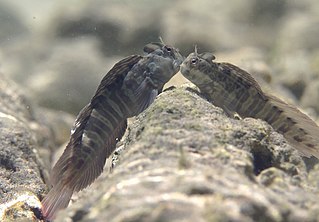
Istiblennius edentulus, the rippled rockskipper, is a species of combtooth blenny found in coral reefs in the Pacific and Indian Oceans. It is also commonly known as the rippled blenny, smooth-lipped blenny, toothless blenny, or coral blenny. Males of this species can reach a maximum of 16 cm (6.3 in) TL, while females can reach a maximum of 13.2 cm (5.2 in) SL.
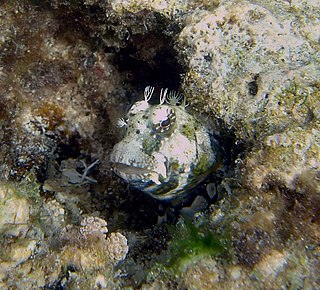
Nannosalarias nativitatis, the pygmy blenny or throatspot blenny, is a species of combtooth blenny found in coral reefs in the western Pacific and Indian oceans. This species grows to a length of 5 centimetres (2.0 in) TL. It is also commonly known as the Christmas blenny or the Christmas Island blenny. This species is the only known member of its genus.

Omobranchus elongatus, also known as the cloister blenny or chevroned blenny, is a species of combtooth blenny found on coral reefs of the western Pacific and Indian Ocean.
Omobranchus obliquus, the roundhead blenny or the mangrove blenny, is a species of combtooth blenny found in coral reefs in the Pacific and Indian oceans.
The cheekspot blenny is a species of combtooth blenny found in the western Indian Ocean, in the Persian Gulf, Gulf of Oman and adjacent parts of the Indian Ocean. This species reaches a length of from 6 centimetres (2.4 in) TL.

Petroscirtes mitratus, the floral blenny, floral fangblenny, helmeted blenny, or the crested sabretooth blenny, is a species of combtooth blenny found in coral reefs in the Pacific and Indian ocean. This species reaches a length of 8.5 centimetres (3.3 in) TL. It is the type species of the genus Petroscirtes.
Petroscirtes thepassii, the Thepas' sabretooth blenny or the Thepas' fangblenny, is a species of combtooth blenny found in the western central Pacific ocean. This species reaches a length of 5.9 centimetres (2.3 in) SL. The specific name of this blenny honours the collector of the type, the military surgeon A.H. Thepass.
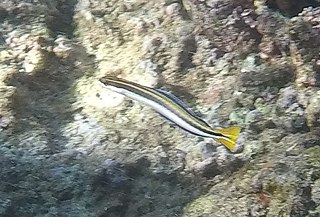
Plagiotremus goslinei, the biting blenny, Gosline's fangblenny, scale-eating blenny or the scale-eating fang blenny, is a species of combtooth blenny found in coral reefs in the eastern central Pacific Ocean. This species reaches a length of 6.3 centimetres (2.5 in) SL. The specific name honours the American ichthyologist William A. Gosline (1915-2002) of the University of Hawaiʻi.

Salarias patzneri, Patzner's blenny, is a species of combtooth blenny found in coral reefs in the western central Pacific ocean. This species can reach a length of 5.5 centimetres (2.2 in) TL. The specific name honours the Austrian ichthyologist Robert A. Patzner who worked on the genitalia of blennies and who shared specimens with Hans Bath.

Xiphasia setifer, the hairtail blenny or the snake blenny, is a species of combtooth blenny found in the western Pacific and Indian Oceans. This species reaches 53 cm (21 in) in SL and is the longest species of combtooth blenny. It can also be found in the aquarium trade.
Emblemaria biocellata, the twospot blenny, is a species of chaenopsid blenny found in coral reefs around Venezuela, French Guiana, and Colombia, in the western Atlantic Ocean. Males of this species can reach a maximum length of 3.8 centimetres (1.5 in) TL, while females can reach a maximum length of 4.1 centimetres (1.6 in) SL.
Emblemaria culmenis, the ridge blenny, is a species of chaenopsid blenny known from a single specimen collected in Venezuela, in the western central Atlantic ocean. It is known to reach a length of 5.1 centimetres (2.0 in) SL.
Emblemariopsis bahamensis, the blackhead blenny, is a species of chaenopsid blenny found in coral reefs in the western Atlantic ocean. It and can reach a maximum length of 2.5 centimetres (0.98 in) TL.
Emblemariopsis occidentalis, the flagfin blenny, blackfin blenny or redspine blenny, is a species of chaenopsid blenny found around the Bahamas, Brazil, and the Lesser Antilles, in the western Atlantic ocean. Males of this species can reach a maximum length of 1.9 centimetres (0.75 in) SL, while females can reach a maximum length of 1.7 centimetres (0.67 in).












